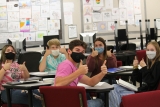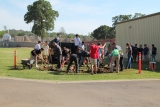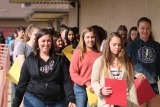-
Category 2
Selected in 2021
-
Grades: 9 - 12
School Setting: rural
Town Population: 3,243
Student Enrollment: 750
Student Demographics:
Black/African American: 0.1%
Teacher/Student Ratio: 1:24
White/Caucasian: 72.7%
Hispanic: 16%
Hawaiian/Pacific Islander: 0.1%
Asian: 2.2%
Native American: 4%
Other: 4.7%
% Reduced Lunch: 46%
% ELL Learners: 2%
Founded: 1981 -
PRINCIPAL:
Josh Mason -
CONTACT:
3805 Happy Valley Road
Cottonwood, CA 96022
530-347-7171 ext. 30001
jmason@auhsd.net
West Valley Early College High School
Cottonwood, CA
We work to 'Find a Way!' "
- 1. Tell us about your school’s success.
-
The staff at West Valley Early College High School has made a concerted effort to improve student learning outcomes during the past few years. In 2013, our school’s A-G rate, College and Career Indicator, and FAFSA completion rates were not very strong compared to similar schools in our state. In order to improve learning outcomes, intentional strategies were developed to not only improve student achievement, but to develop a culture where all students are capable of academic success. Our staff focused on data driven practices to identify critical learning needs of our students and how we could improve their learning outcomes. After many years of hard work and dedication by students, staff, parents, and the community, we have significantly improved our student achievement percentages. Our A-G rate, College and Career Indicator, and FAFSA completion rates are among the highest in Shasta County. Our team continues to identify areas for improvement and the growth mindset that has been developed by stakeholders has changed the academic culture within our school and has elevated our campus to what it is today.
- 2. Talk about the greatest contributing factor(s) that promoted positive change in your school.
-
The motto of WVECHS is to “Find a Way” and our mission is to provide a rigorous and relevant learning environment that prepares all students for post-secondary academic achievement and success in the career pathways of the 21st century economy. To make our motto and vision a reality, stakeholders had to commit to developing a culture of reflective practice to improve student achievement. Revising course offerings, participating in professional development learning communities, evaluating data, and rebranding our school as an early college high school were all contributing factors that promoted positive change in our school. These factors were all important in increasing student achievement, however, the commitment to developing a culture where all stakeholders believed students could succeed was the greatest contributing factor.
- 3. How has ESEA funding supported the school's success?
-
WVECHS uses ESEA funds to provide in-class supports for struggling students, counseling services, supplementary materials, and professional development opportunities for staff. English and math lab classes have been created to help struggling students receive Tier 2 supports during the school day. When students are placed into these classes, they benefit from the small class sizes so they can receive more one-on-one intervention support from credentialed math and English teachers. The funding program provides us with opportunities to secure additional counseling and psychology staff so students are receiving the academic and social-emotional supports to succeed. ESEA funds are used to purchase various supplementary materials for struggling students and the funds helped us become a 1:1 campus in 2020 as we were able to purchase Chromebooks for any student who needed an electronic device. We also allocate ESEA funds for various professional development trainings and to our Link Crew who conducts several activities for students each year.
- 4. What professional development activities were used to improve teaching and learning?
-
The staff at WVECHS participated in many professional learning communities the past few years to improve our educational practices. They participated in various trainings, professional development conferences, and attended many collaborative sessions to evaluate our practices and implement new strategies to increase student achievement. Teachers improved their teaching practices by evaluating assessment data to determine critical student learning needs. Once the learning needs were identified, they worked collaboratively in professional learning communities to identify what curriculum and instructional practices needed to be implemented in classrooms. Many teachers also participated in cohorts to evaluate current trends in equitable grading practices, educational technology trainings, and worked in the summer to develop benchmark and interim assessments. The school counseling department participated in a Hatching Results professional development cohort for three years to improve their practices as a department and completely overhaul how they operate as a team. They developed a Tier 1 core counseling curriculum for every grade level with assessments to track the effectiveness of the curriculum and Tier 2 academic groups were formed to assist struggling students. When the curriculums were implemented at WVECHS, it reduced the number of failing students by close to 50%. They also created workshops for FAFSA and college registrations to support students and families matriculating as high as 71% of our senior students.
- 5. Talk about the cultural shift leading up to your school's success.
-
WVECHS has always been a great institution with amazing teachers, support staff, students, and families. We have fantastic academic and extracurricular programs that offer students a unique educational experience in our area. However, in years past, WVECHS lacked a clear vision for creating a culture that prepared all students for post-secondary academic achievement and success in career pathways. This was not due to a lack of highly qualified teachers and staff, but the focus was not clearly defined. This changed when we started to be intentional about data tracking and creating clear pathways for student success. We instituted four-year plans with our freshman students and the counseling staff reviewed them often to ensure that our students were on-track for as many options after high school as possible. A-G, college dual enrollment, and career and technical education (CTE) course placements were strategic and tracked closely. Yearly digital transcript audits were instituted to redirect students who were off-track and the master schedule was strategically created to ensure that any new course offered would be purposeful in meeting the needs of our students. Another important factor in creating a culture where all students had the opportunity to succeed was our transition to an early college high school. Teachers, counselors, support staff, and administration committed to establishing an institution that valued dual enrollment classes so our students could take college courses on our campus. We currently offer our students the opportunity to earn up to 60 college credits by taking traditional, articulated, and facilitated dual enrollment courses. Starting next year, we are offering our students the opportunity to complete all California State University general education course requirements with the implementation of additional dual enrollment courses. We also offer various CTE pathway opportunities on campus and partner with the Shasta-Trinity Regional Occupational Program to offer additional career training opportunities for our students. These programmatic changes have created additional learning opportunities for our students and assisted in the formation of a culture that prepares all students for post-secondary academic achievement and success in career pathways.
- 6. How has community involvement strengthened your success?
- WVECHS is an integral part of the Cottonwood community. Parents, community members, and local businesses are extremely supportive of our school. Various partnerships have been established with local stakeholders that help us develop our School Plan for Student Achievement, our district Local Control Accountability Plan, and our Career and Technical Education Advisory Council. Local community organizations, businesses, and families generously donated over $300,000 in scholarship money to our graduating seniors last year. Our FFA, Leadership, Link Crew, and National Honor Society organizations conduct many community service projects throughout the year that rely on community donations to secure funding for projects. We have an active WVECHS Sports Boosters Club that helps purchase athletic equipment for our sports teams and operates food services at all of our athletic events. Our athletic programs provide quality experiences for our community not only through championship seasons but also through community give back programs as well. We are proud to have great community partners and appreciate all that they do to make our school great.
Stats
-
Category 2
Selected in 2021
-
Grades: 9 - 12
School Setting: rural
Town Population: 3,243
Student Enrollment: 750
Student Demographics:
Black/African American: 0.1%
Teacher/Student Ratio: 1:24
White/Caucasian: 72.7%
Hispanic: 16%
Hawaiian/Pacific Islander: 0.1%
Asian: 2.2%
Native American: 4%
Other: 4.7%
% Reduced Lunch: 46%
% ELL Learners: 2%
Founded: 1981 -
PRINCIPAL:
Josh Mason -
CONTACT:
3805 Happy Valley Road
Cottonwood, CA 96022
530-347-7171 ext. 30001
jmason@auhsd.net










